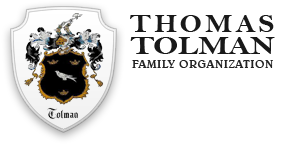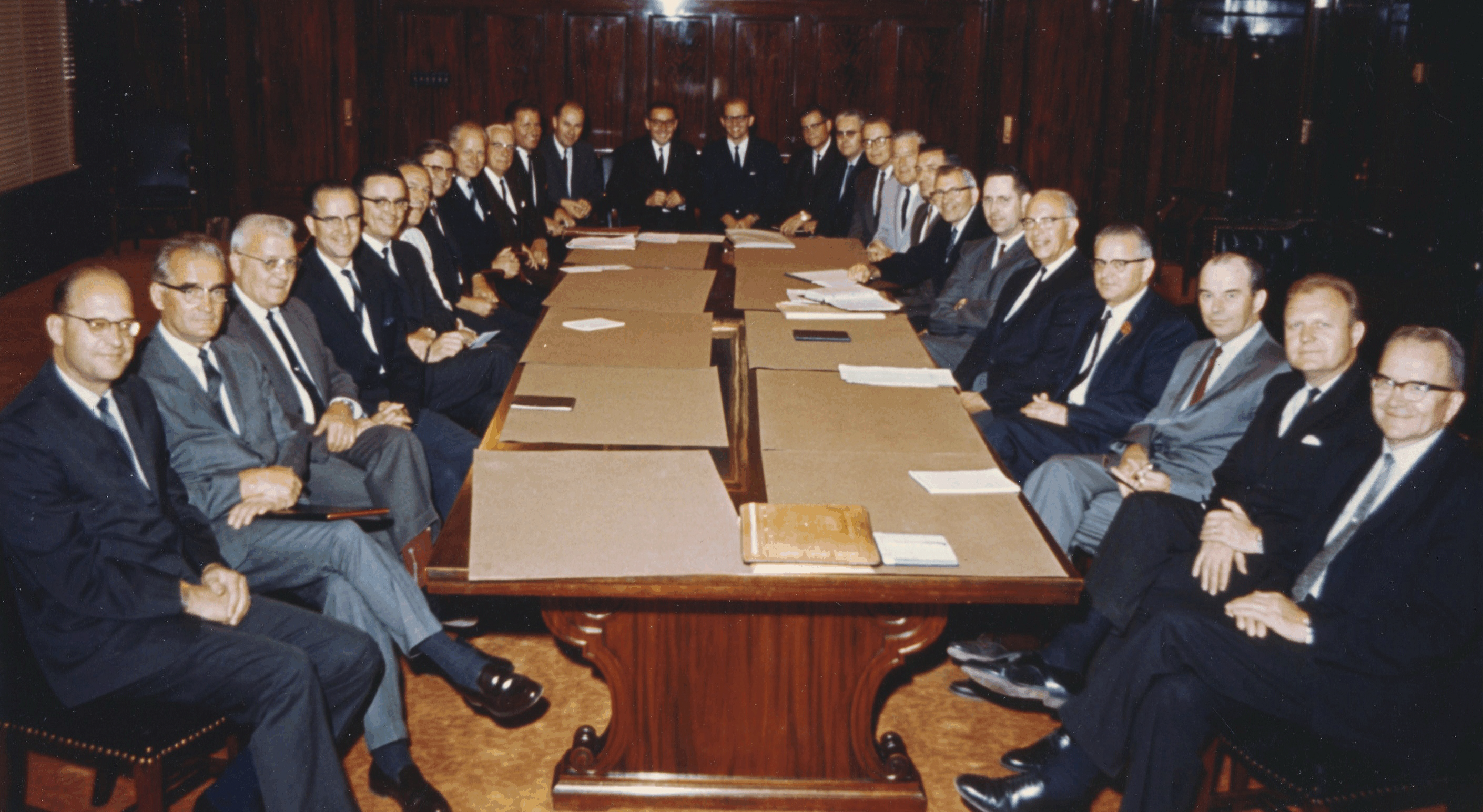In 1930, William wrote on the inside cover of his missionary journal, “My life work if God wills – Scouting – helping boys, helping girls, helping others, those who need help.” He also listed under the heading “‘Important,’ 32 things that I want to do.” Among those 32 items was “Remember to spend all possible time hunting for genealogy when I get home.”
He served in many Church callings related to genealogy including Stake Genealogy Committee, Stake Genealogy Committee Chairman, Stake Melchizedek Priesthood Genealogist, Stake Genealogy Instructor, He was the merit badge counselor for the genealogy merit badge.
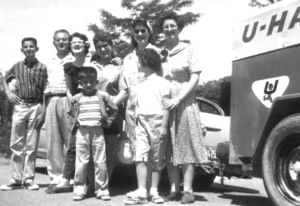 In the summer of 1959, William taught on the Genealogy Circuit for BYU and traveled nearly 8,000 miles with his wife and six children over a 14-week period. Here are a few excerpts from William’s history from that circuit:
In the summer of 1959, William taught on the Genealogy Circuit for BYU and traveled nearly 8,000 miles with his wife and six children over a 14-week period. Here are a few excerpts from William’s history from that circuit:
13 Jun 1959: Opal and I arose about 5:00 a.m. and accompanied F. Lant Haymore and Brother Jensen to the Arizona Temple at Mesa. It was a special priesthood session for the Tucson and first time in this temple. On the way home from Mesa we stopped at the Casa Grande National Monument an old Indian ruins from the groups that had large irrigation projects. It was 116 degrees today. I am convinced that I want to live right, because I have no desire to go to a place which has a chance of being hotter than this. This first week of classes has been an inspiration to me – these people are wonderful! They want to learn how to keep records and do research.
8-20 Jun 1959: My BYU courses in Tucson, Arizona are two beginning classes. A sample of comments sent to BYU: 1) “More genealogy by Tolman.” 2) “I think Brother Tolman is an excellent teacher and a very fine man. He has given me the shot in the arm that] needed.” 3) “Brother Tolman has been a wonderful teacher and taking the course has been worth 150 mile round trip each class.” 4) “I have enjoyed this course very much, and I thought that Brother Tolman was excellent. I received more than my money’s worth the first night.”
Sunday, 28 Jun 1959: We have many people in class from Gallup, New Mexico and also my nephew, Merlon Tolman, is serving as a missionary there. So, early this morning we left for talk to them on the Book of Mormon and then he interpreted my entire sermon for the benefit of those who did not understand English. Gallup to attend Sunday School at the Indian or Lamanite Perea he waited until I had completed. Last spring as I taught a genealogy class in Springville I met an Indian lady whose daughter was living with Brother and Sister Frank Patton, genealogy chairman of Springville, and attending school. The husband of this same lady is the branch president here in Perea. His wife remembered us. What a small world. After sacrament meeting we returned to St. Johns. We hadn’t gone far when we realized that Darrel was not in the car with us and returned to the meeting house. There he was found, locked in the bathroom. When we arrived at St. Johns, I went on to Eagar where I met with the stake genealogical committee for one and one half hours answering questions and giving council on how to make the best use of the spirit and training developed in this class. Then I attended sacrament meeting at the Eagar Ward where I was called out of the audience to be the concluding speaker with this remark from the bishop’s counselor, “This meeting wouldn’t be complete without hearing from Brother Tolman.” After sacrament meeting we held genealogy class for the Eagar section. This decision was made by the stake presidency and bishops involved so that class would not be held next Saturday night on the July 4th holiday.
3 Jul 1959: Like last night I met the young people for one and a half hours before regular class – about sixty were in attendance of same ages as at Eagar. In this stake as also in Tucson Stake they have been conducting a very successful junior genealogy class each week – not on Sunday. As the class in St. Johns concluded tonight, Judge J. Smith Gibbons said, “It is our feeling that we would like to give a standing ovation to Brother Tolman for his services.” All present (about two hundred) stood up. I choked up and could hardly make a response to such a demonstration. These classes have been so very successful because the leadership was actively behind the program. President Whiting attended all classes at Eagar. President Greer, his counselor, attended all classes at St. Johns and some at Eagar. Many high councilman attended. Bishops and counselors, quorum presidencies, auxiliary leaders and ward clerks attended from most wards and branches. When they set up the classes they raised the money by assessing the priesthood quorums. Then all that wished could attend class, male and female. A surprising number of youth were religiously present at each class in St. Johns and Eagar. Many people came up after class and made statements that almost seem impossible. One young man, I would judge about 18 years of age said, “Oh, Brother Tolman, this is the greatest experience ofmy life.” A seventeen year old young lady literally threw her arms around me and said, “Words can’t express my gratitude for what you have given me in this class.” The wonderful lady who played the piano for all our opening exercises in St. Johns said, “I am so thankful for your help.” And then she cried. A high school student said, “Brother Tolman, why can’t you come and teach our seminary class?” One of the enthusiastic men of the class said, “Your ability is being wasted in Utah. We would like to move you to St. Johns.” Well, enough of this boasting with this concluding statement. One lovely person kindly said, “Every session of this class has been better than any stake conference I have attended.” I want to record here that this was one of the most humbling experiences of my life. God literally came to my assistance in meeting the challenge of these two large classes. I am grateful to the BYU Extension for this opportunity. I am grateful to the people who attended. I thank my Heavenly Father every day and especially I am thankful for my wife and children. If my wife and three eldest daughters had not helped, I would never during the two weeks have completed correcting and recording the assignments on these two large classes.
5 Aug 1959: Class was held tonight at Walla Walla with four more people enrolled. One of the students, Sister Ruth E. Stoddard said, “I don’t want a make up lesson on #1. I have heard about it and I want the entire lesson. I will make arrangements to attend your first class in Portland.” Sister Vivian G. Gessel, a convert to the church said, “Brother Tolman, I was very discouraged in my research work, but you have changed my whole outlook and feeling. Won’t you please come to my home with your family and spend Friday afternoon. The children can swim in our large private pool while you help me on my problems, and then I would like you to have dinner with us before you go to class.” Sister Florence H. Davis said, “Ij ust can’t express our appreciation, because I get all choked up and will break down and cry.” The Lord has surely blessed me and these wonderful people are a blessing and inspiration to me. I must not fail them, but humbly teach them.
6 Aug 1959: Early this morning my wife woke me up and informed me that in my sleep I had been explaining, using my hands to emphasize, how to make out genealogy sheets. I sat up in bed, shook her and exclaimed, “Now this is the way to do it: Identify each person by using names, places, dates and relationships. Do you see? Do you understand what I mean?” She agreed with me, and I lay down and continued my sleep.
10 Aug 1959: Today I worked on my lesson for tonight and my daughter Loraine prepared additional visual aids for me. My first appointment was at 6:00 p.m. at the Walla Walla Ward chapel with Sister Vivian Jorgensen to help her resolve some of her research problems. We had an excellent class tonight with Brother and Sister Hiatt as visitors. He is high priest group leader in the ward. After class they said, “Oh, Brother Tolman, you have given us so much help in this lesson tonight. We appreciate very much having been invited to attend.” Brother Harrison of the stake committee said, “This has done more to increase this spirit in our stake than any thing that has ever before happened. Also the presence of the spirit of your three older daughters has done somethingfor our young people that is very difficult to explain. They have shown to our youth the power of the gospel and the spirit of leadership.” Even after three hour classes they were still reluctant to leave. I acknowledge the hand of God in the spirit that has been present in these classes and for any good I have been able to do or help I have given.
12 Aug 1959: I spent the morning working with Loraine on my Book of Remembrance; then prepared for class and filled my first appointment for the day 3:00 p.m. at home of Sister Audra Ord to help her on genealogy problems. Then I got set up for the class and with my family had dinner with Brother and Sister Ord at 824 Wauna Vista Dr. Back to the class for appointments from 6:00 to 7:00 p.m. and then class at 7:00 p.m. A telephone call from Portland verified the number (approximately) in the two classes-this call from Jay Lunday about 5:30 p.m. A very fine spirit prevailed in class tonight and people expressed their appreciation for the lessons. Sister Gessel is leaving on vacation in the morning. She said with great emotion, “Brother Tolman, I hope I can keep the driving spirit that you have given me to do this work. JJ Sister Vivian Jorgensen said, “I have a compliment from my eight year old daughter. She said after sacrament meeting last Sunday night, ‘now that is the kind of speaker I like to listen to. I could understand what Brother Tolman was talking about.'”
14 Aug 1959: I arrived at the chapel at 6:30 p.m. for my last class at Walla Walla. We had about 100 people present and after class which we closed early (1/2 hour) for viewing displays of genealogy work and refreshment, the people still lingered on until 11 :00 p.m. Bishop Fredrickson gave a powerful closing prayer and then cried as he thanked me for the spirit these classes had brought into his ward. One sister said, “Brother Tolman, a spirit has come into our ward in this last two weeks which I have never felt before-even our young people have felt it.” Many other statements equally as wonderful were made and it is really a very humbling experience as I realize what God had done for these people and myself in such a short time. I actually would like to stay with these people as they have requested.
20 Aug 1959: My first appointment was at my home at 8:00 a.m. with Russell Kenaga. He had questions on his indexing of research records and information. I am satisfied that I gained much more from him than he did from me. I believe his system should be published as a guide for the “keen” minded researcher. This man really has the vision of research by correspondence and he has followed that vision as has no one else in my acquaintance. I arrived at class early tonight to visit with several people. A few more were present tonight and I suppose the total enrollment in the two classes is now about 120 students. We have at least one bishop and one member of the Portland Stake presidency in class and a powerful spirit prevails. The one thing that disturbs me, however, is that members of the stake committee in both stakes, excluding both chairmen, admit they know very little about the work, but are not registered in class. This is just the opposite of other committee members – the leadership must show the way. After class tonight President Emmett (member of stake presidency) came up to me and said, “Brother Tolman, we have had many people in our stake from headquarters, but none more inspirational than you and that includes our general authorities. You have really touched our hearts tonight: I love your form of presentation. It is not only instructive, but it creates a driving desire to do this work.” One lady said, “Oh, Brother Tolman, if I could tell a story like you do, I would have all the people in my ward converted to genealogy.” Another person said, “My only trouble tonight was that I didn’t bring a large enough handkerchief to cry into.” Several other people expressed appreciation and congratulations. May God bless them with the vision of this great work and the driving power to do it.
29 Aug 1959: I spent the morning correcting papers and at 1 :00 p.m took the family to Laurelhurst Park to attend the special picnic party given in our honor by the Columbia River Stake. It was attended by a small group and the day was beautiful. After a dinner of fried chicken with all the trimmings, they had a lovely program. It was very entertaining. They presented me with large salad bowl with spoon and fork all made from Myrtlewood. It is really a humbling experience to be treated so royally. At our final class tonight companions of class members, stake presidencies and wives, high councilmen and wives, bishoprics and wives with other ward and stake officers were invited. The attendance was well over two hundred and fifty people and it was a great climax to our summer program. After class the Portland Stake served punch and cookies while everyone enjoyed looking at the display of Books of Remembrance, wall pedigree charts and family trees. It is about 11 :30 p.m. before all finally decided to go home. One lovely sister came up to me and said, “Brother Tolman, you ‘U never know what you have done for me.” And then she started to cry. President Emmett of the Portland Stake presidency came to me, put his arm around me and said, “Brother Tolman, 1 want to tell you just two things; first, this has been the greatest inspiration in genealogy that we have ever received in this stake and second, it has given the entire stake a spiritual uplift that exceeds anything we have experienced in the past. I thank you in behalf of the stake and may God bless you.” Truly this has been a climax to this wonderful summer circuit. May all these people keep and increase the spirit of this important work is my constant desire.
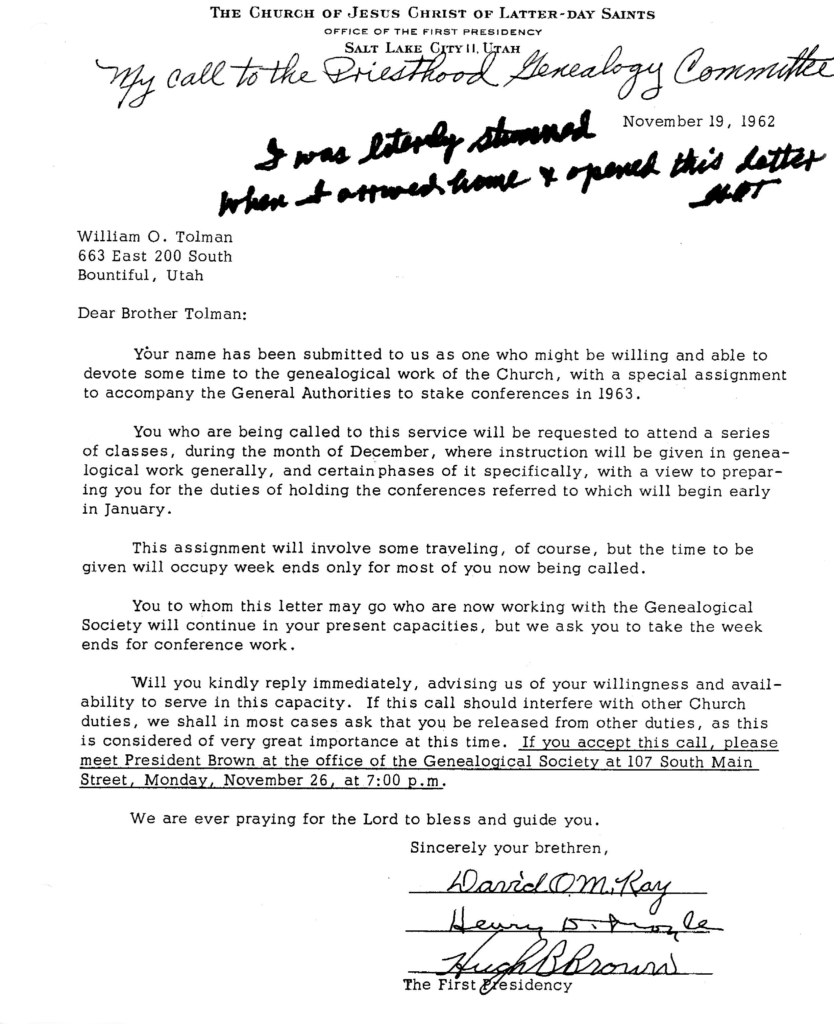
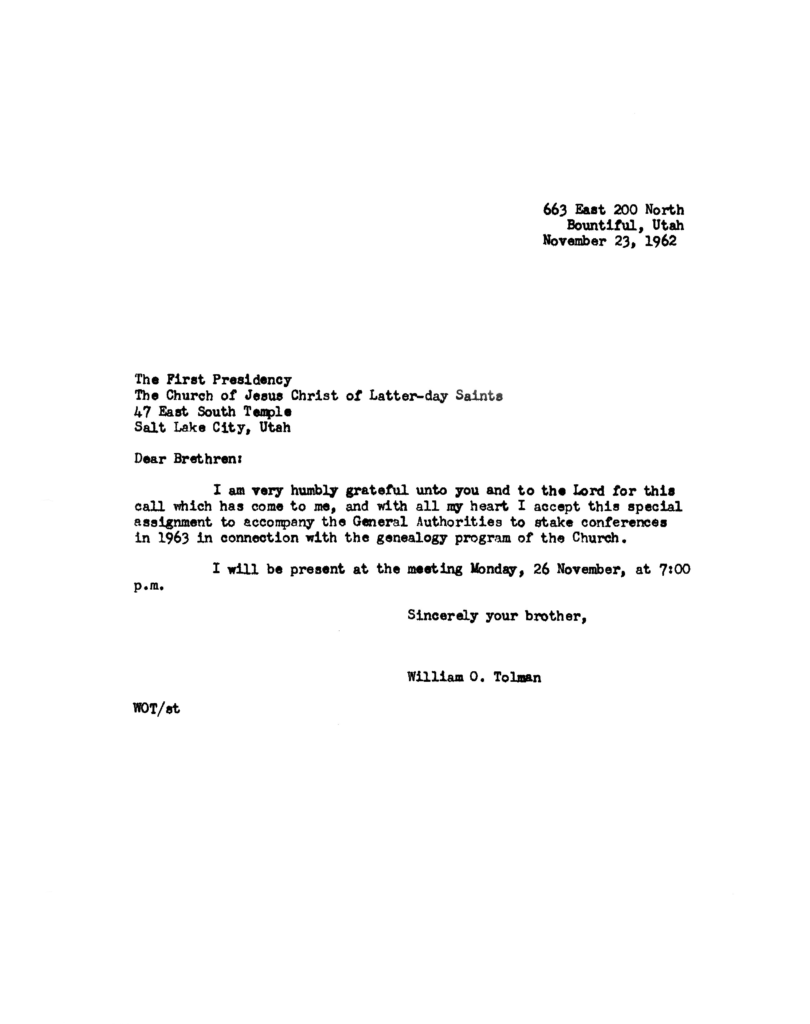
26 Nov 1962: We had our choice today of 7:00-9:00 a.m. or 6:30 to 8:30 p.m. for the beginning of our conference staff training. It is going to be very intensive training for the next few weeks. President Hugh B. Brown, President Jackson, and George H. Fudge instructed us. President Brown said, “You have been approved by the First Presidency. The genealogical work of the church is now big business. The work lying just ahead in this field is even greater than our present missionary program or it is really an extension of the missionary work and program. You are to challenge this almost untapped field… This is authoritative-as a church we are prepared to spend millions of dollars to accomplish this work.”
Sunday, 16 Dec 1962: President Hugh B. Brown and Henry E. Christensen taught us about the third session on Saturdays, lesson guide number four. President Brown said, “You will be traveling as a special representative of the First Presidency. Be yourself, feel free and relaxed. Don’t speak too long-if they give you twenty minutes take nineteen. Contact the general authority and ask him what his pleasure is as far as travel – when, where and how. I have told the President (McKay) we don’t have a better flying squadron in the church.”
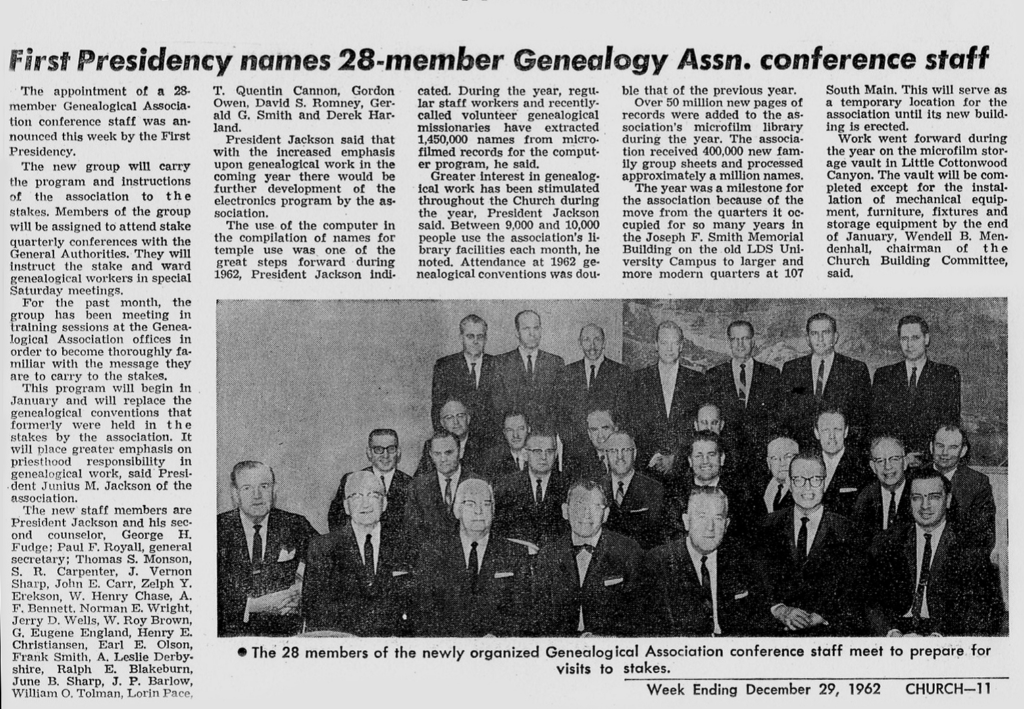
Saturday, 5 Jan and Sunday, 6 Jan 1963: My first conference assignment was this weekend to the Sevier Stake in Richfield, Utah (President Alton Christensen). I accompanied Elder Marion G. Romney and Elder Mark B. Garff. I was literally trembling all over and so expressed myself to the congregation and then added, brothers and sisters, I hope the time will come when I can stand at a stake conference and speak without all this fear in my heart and soul. Elder Romney spoke up so that all the congregation could hear and said, “YOU WON’T, BROTHER TOLMAN, YOU WON’T” Then he told me after the meeting that if the time ever came that I did, I should go alone and get on my knees and find out what is wrong with me.
24 Feb 1963: I attended two stake conferences as companion to Spencer W. Kimball, an Apostle.
13 Apr-Sunday, 14 Apr 1963: They assigned me this week to Beaver, Utah Stake (President Wallace Dudley Yardley) with Elder Joseph Fielding Smith and Walter Dansie of the Priesthood Welfare Committee.
Saturday, 11 May-Sunday, 12 May 1963: My conference assignment was to South Sevier Stake in Monroe, Utah (President Rulon Rasmussen) with Elder Harold B. Lee and William T. Lawrence. I wrote a letter to President Tanner to accept the call to assist with the preparation of genealogy teaching materials.
21 Mar-Sunday, 22 Mar 1964: My assignment this weekend was to Timpanogos Stake in Pleasant Grove (President Boyd LeRoy Fugal) with Ernest A. Strong of Welfare. The receptive spirit of the leadership and people of this stake was outstanding. The stake president gave the genealogical challenges to the people of his stake at the close of conference on Sunday. As he came to the commitment of the number of endowments for this year he said, “We had 2800 last year and I have committed us to 3500 this year.” He paused for just a moment and then continued, “We can do better than that. Brother Tolman, change the 3500 to 7500 and we will do it.” He also doubled the number of family group sheets and said, “We will start right now, and we will do better than that.”
28 Mar-Sunday, 29 Mar 1964: I was assigned to the East Jordan Stake in Midvale, Utah (President Donald B. Milne) with Elder Joseph Fielding Smith and William T. Lawrence.
5 Jun – Sunday, 6 Jun 1965: I was assigned with Elder Henry D. Taylor to the Garden Grove, California Stake this weekend.
7 Jun 1965: We went to Disneyland today.
13 Nov-Sunday, 14 Nov 1965: My assignment to the Monument Park Stake in Salt Lake City was with-Elder Marion G. Romney and Minnie E. Anderson.
20 Nov-Sunday, 21 Nov 1965: I was assigned to the Davis Stake with Elder LeGrand Richards. He said to me, “Sell the Program.” This I attempted to do in every meeting where I spoke. When I sat down after speaking in the afternoon session on Sunday he said, “If that doesn’t get action, then we might as well go home.” It is true that they have about 550 sheets in process in the stake and most of them are now in the homes of people who refuse to copy them over and abbreviate the counties, states, months, etc. I was really surprised. What a revelation!
4 Nov-Sunday, 5 Dec 1965: My stake conference assignment was to North Sacramento (President Lester D. Call) with Elder Marion D. Hanks and J. Elliot Cameron of the Sunday School. It is in North Highlands, California. My son John picked me up at the airport and I stayed with him Friday and Saturday evenings. They have a well informed but pessimistic high council advisor. Good but uninformed bishops, interested high priest group leaders and examiners and a stake membership waiting for direction. Everyone waiting for everyone else to move first and everyone blaming everyone else for failure of the program. I met my cousins at the home of my son John on Friday evening. It was an exciting experience to find that I have about 50 cousins living in this area. We organized the family with Bishop Keplar C. Tolman as area representative, his wife as secretary and 7 other couples to be on the seven operating committees of the family. The thrilling thing was the fact that they were just waiting to be activated in the family organization. Two of my boy scouts of 30 years ago were present – one a high priest group leader, the other President Melvin Woodland of the American River Stake. My three grandchildren fought to see who would sleep on the floor close to my bed Friday and Saturday nights – two of them succeeded.
22 Jun 1966: At 7:00 p.m. the Dedication of the Granite Mountain Records Vault took place. Elder Howard W. Hunter, President of the Genealogical Society, conducted. The general authorities present were President Hugh B. Brown, President N. Elden Tanner, Elders Harold B. Lee, Mark E.Peterson, Marion G. Romney, LeGrand Richards, Eldred G. Smith, EIRay L. Christiansen, Sterling W. Sill, Henry D. Taylor, Theodore M. Burton, S. Dilworth Young, Milton R. Hunter, Marion D. Hanks, Paul Dunn and Franklin D. Richards. 29 members of the priesthood genealogy committee, all accompanied by their wives, were present, plus about that many more guests. President Tanner said, “President McKay sends word, ‘Remember who you are and your great responsibility. This is an historic occasion. This is an inspired program and this vault was built under inspiration.'” President Brown, who spoke and dedicated the vaults, said, “Some people would think as we meet in a mountain to honor the dead that we would be a rather gloomy group and so I am glad that Elder Hunter has left us in a happy mood. In 1961 the construction actually began and it was completed in 1965. 100 years of London Times could be microfilmed and stored in 2 shoe boxes. It is a wonderful thing to be a part of a great living, pulsating organization that looks with such dedication to the future and connecting the present with the past.”
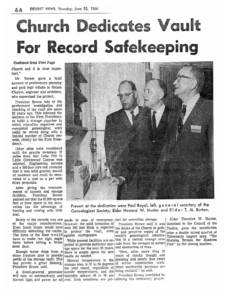
22 Jun 1966: At 7:00 p.m. the Dedication of the Granite Mountain Records Vault took place. Elder Howard W. Hunter, President of the Genealogical Society, conducted. The general authorities present were President Hugh B. Brown, President N. Elden Tanner, Elders Harold B. Lee, Mark E. Peterson, Marion G. Romney, LeGrand Richards, Eldred G. Smith, EIRay L. Christiansen, Sterling W. Sill, Henry D. Taylor, Theodore M. Burton, S. Dilworth Young, Milton R. Hunter, Marion D. Hanks, Paul Dunn and Franklin D. Richards. 29 members of the priesthood genealogy committee, all accompanied by their wives, were present, plus about that many more guests. President Tanner said, “President McKay sends word, ‘Remember who you are and your great responsibility. This is an historic occasion. This is an inspired program and this vault was built under inspiration.'” President Brown, who spoke and dedicated the vaults, said, “Some people would think as we meet in a mountain to honor the dead that we would be a rather gloomy group and so I am glad that Elder Hunter has left us in a happy mood. In 1961 the construction actually began and it was completed in 1965. 100 years of London Times could be microfilmed and stored in 2 shoe boxes. It is a wonderful thing to be a part of a great living, pulsating organization that looks with such dedication to the future and connecting the present with the past.”
Saturday, 25 Jun-Sunday, 26 Jun 1966: I was assigned to the Mt. Olympus Stake (president Orin Richard Woodbury) with Elder Thomas S. Monson, Elder Sterling W. Sill and Sister Hulda Parker Young, the General Relief Society secretary. The stake had a printed program with pictures of us four visitors and a very brief biography. I received a letter from the East Mill Creek 5th Ward bishopric, A. Lewis Skanchy, bishop. It said, “We feel that your enthusiasm and deep interest in this phase of the Lord’s work will have motivated more people to fulfill their responsibility in this area than anything else that we have experienced in the past.” President Monson said at the conference, “You ‘U never find truth searching through fields of ERROR.”
3 Sep-Sunday, 4 Sep 1966: My conference assignment was with President Joseph Fielding Smith and Sister Young of the Relief Society to North Rexburg Stake (President Orval P. Mortensen). President Meyer’s wife and I are cousins.
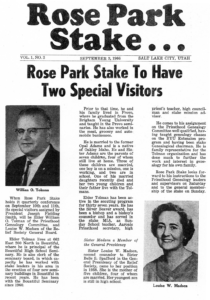 10 Sep-Sunday, 11 Sep 1966: My assignment to the Rose Park Stake (President Joseph Fielding Steenblik) was with President N. Eldon Tanner and Sister Louise Madsen “Pressure is good if we take it.” “High failure is greater than low success.
10 Sep-Sunday, 11 Sep 1966: My assignment to the Rose Park Stake (President Joseph Fielding Steenblik) was with President N. Eldon Tanner and Sister Louise Madsen “Pressure is good if we take it.” “High failure is greater than low success.
Saturday, 15 Apr-Sunday, 16 Apr 1967: I went to the Sandy East Stake (President Orren J. Greenwood), with Elder Thomas S. Monson, who said, “Be a willing worker. Be a devoted worker.” He told a story of missionaries talking to a nonmember about the church magazines who asks, What was the prophet’s message to the world last month? “Well we haven’t had time to read it.” The month before? “90% of all questions written by priesthood leaders and sent in to the general church are answered in the handbooks or priesthood bulletins… One bishop said to his smoking teacher, ‘George, I’m filling out a recommendfor you. ”What, I can’t have a recommend, I smoke.’ ‘I know, that’s why I’m not signing it, but] want you to put it on your dresser and look at it each morning.’ He did look at the recommend, his wife and children and he threw away his tobacco and is now on the high council.
Saturday, 6 May-Sunday, 7 May 1967: My conference assignment was to Cassia Stake (President Wade Baker), with Elder Theodore M. Burton. I took family with me on this visit. Only about ten percent of the Melchizedek Priesthood in this stake attend the temple regularly. I’m surprised at how little we use the church publications to actually find out concerning our callings.
13 May-14 May 1967: I was assigned to the Wells Stake in Salt Lake City with Elder Marion G. Romney for their stake conference in the Granite Tabernacle. They set a very high standard in ordinances for the dead. Last year they were second in the number of endowments done in the whole church.
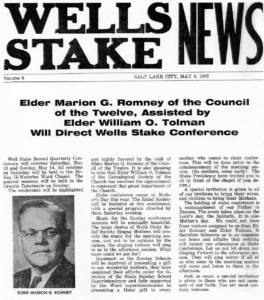 Saturday, 27-Sunday, 28 May 1967: I was partnered with Elders Howard W. Hunter and Eldred G. Smith, church patriarch, to the Wayne Stake in Loa, Utah (President Voyle L. Munson). The “Five Pathways” by Elder Thomas S. Monson were shared: 1) When you see sin, shun it. 2) When you have a duty, do it. 3) When you enjoyfreedom, protect it. 4) When you have the truth, live it. 5) When you have a testimony, share it. I was shocked and surprised as I met with the high council advisor to find that he knew almost nothing about what was going on. The wonderful stake president was not much more knowledgeable. The ward record examiners were floored when I explained their responsibility and opportunity. They have asked me to return in June. Elder Howard W. Hunter asked the new stake president, President Albrich to write President Burton making the request.
Saturday, 27-Sunday, 28 May 1967: I was partnered with Elders Howard W. Hunter and Eldred G. Smith, church patriarch, to the Wayne Stake in Loa, Utah (President Voyle L. Munson). The “Five Pathways” by Elder Thomas S. Monson were shared: 1) When you see sin, shun it. 2) When you have a duty, do it. 3) When you enjoyfreedom, protect it. 4) When you have the truth, live it. 5) When you have a testimony, share it. I was shocked and surprised as I met with the high council advisor to find that he knew almost nothing about what was going on. The wonderful stake president was not much more knowledgeable. The ward record examiners were floored when I explained their responsibility and opportunity. They have asked me to return in June. Elder Howard W. Hunter asked the new stake president, President Albrich to write President Burton making the request.
Saturday, 9 Dec-Sunday, 10 Dec 1967: My assignment this weekend was the Yellowstone Stake in St. Anthony, Idaho (President Max C. Mortensen). I accompanied Elder Ezra Taft Benson, Elder Franklin D. Richards and Sister Margret P. Ottosen of the Primary. It was very revealing to find that 60% of high priests hold recommends, but only 20% attend the temple regularly. Only 17% of the seventies and 5% of the elders attend the temple regularly. The people do not know what they should do or how to do it. Elder Franklin D. Richards said, “To prepare to die is not the counsel to LDS, but rather prepare to live.” Elder Benson said, “God hasn’t said much about office. It isn’t where you serve, but how. Sometimes our sons have a greater spirit than their fathers. Joseph Smith received revelation for his father. Joseph in Egypt saved his father Israel. Nephi was the inspiration to his father Lehi.”
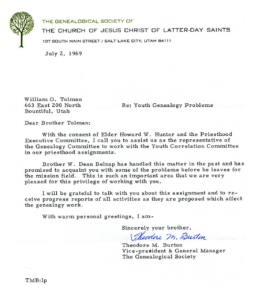
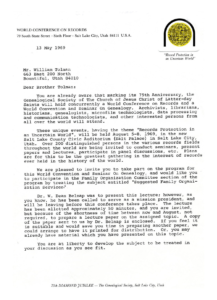
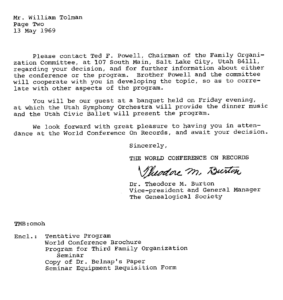
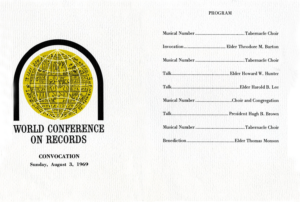
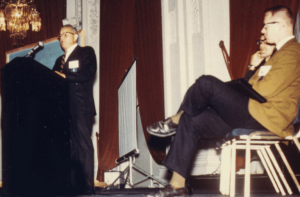
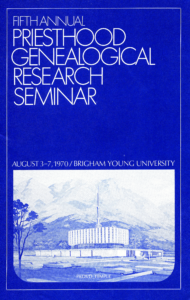
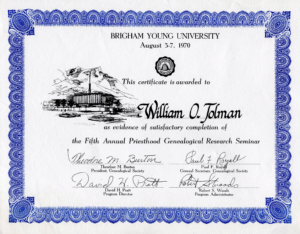
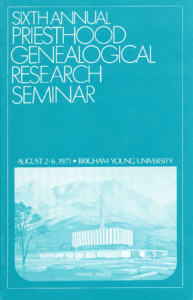
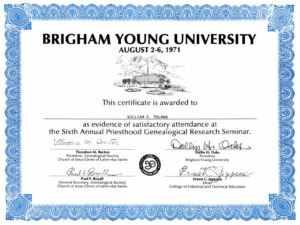
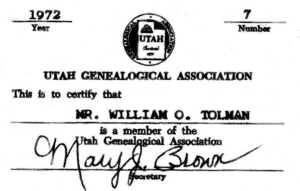
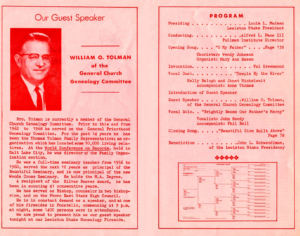
William served as the Family Genealogist on the Thomas Tolman Family Organization Executive Board in 1959 and served in that position until his passing in 1980. He believed the key to genealogy and family history work was “to get a lot of people to do a little.” When he received the many boxes of records that had been accumulated by Aunt Myra, which he first estimated to be over 200,000 names, he had to determine what to do with them. It was decided that Myra’s records must be indexed in order to know what research had been done. Beginning November 1962, Saturday work-days were established to put the record onto index cards. An average of twenty-five relative same each month, with a record month of seventy-five. In the spring of 1961, William received a form letter from cousins in Fairacres, New Mexico. That letter was followed by a personal letter dated 28 August 1961. He answered, and a chain of letters resulted in a personal visit from Fred and Arlene Tolman and an exchange of genealogy data, between 1965 and 1967, that amounted to about 25,000 new family group sheets. William was truly a visionary man and by the mid to late 1970s fort-three secretaries had been called to keep in touch with fifty-nine governing board members and 192 research chairmen. As William taught classes and traveled to conferences he heard enough said stories about family records that were lost or destroyed or would not be shared to convince him that the Tolman records needed a home of their own. The result was the building and dedication of the Thomas Tolman Family Genealogy Center on July 7, 1978. William and Opal Tolman became the caretakers to the center and hosts to the family family members. (Thomas Tolman Family Organization: A Hundred Year History, compiled by Loraine Tolman Pace, 2003, pages 77-78).
On April 8, 1962, William motioned that the Nathan Tolman Family Organization be changed to the Thomas Tolman Family Organization after our immigrant ancestor. William often expressed his love for all of his cousins regardless of their faith or background. (Note: Judson Tolman formed this organization in 1903 and named it the Nathan Tolman Family Organization after his father. The organization has always been closely tied to the Family History and Genealogy program of the Church of Jesus Christ of Latter-day Saints). (Thomas Tolman Family Organization: A Hundred Year History, compiled by Loraine Tolman Pace, 2003, page 98).
(Contributed by the Thomas Tolman Family Organization. Unless otherwise indicated, excerpts from William Odell Tolman: Patriarch, Genealogist, Teacher compiled by Loraine Tolman Pace, First Edition, 2009, pages 47, 208-209, 212-214, 220-223, 226-227, 282, 284-285, 289, 292, 295, 305, 321-323, 330, 333, 336, 338, 341-342, 345, 540).
Visit FamilySearch to learn more about William Odell Tolman and other ancestors. Also visit the Thomas Tolman Family Organization to find out how you can get more involved in family history.
